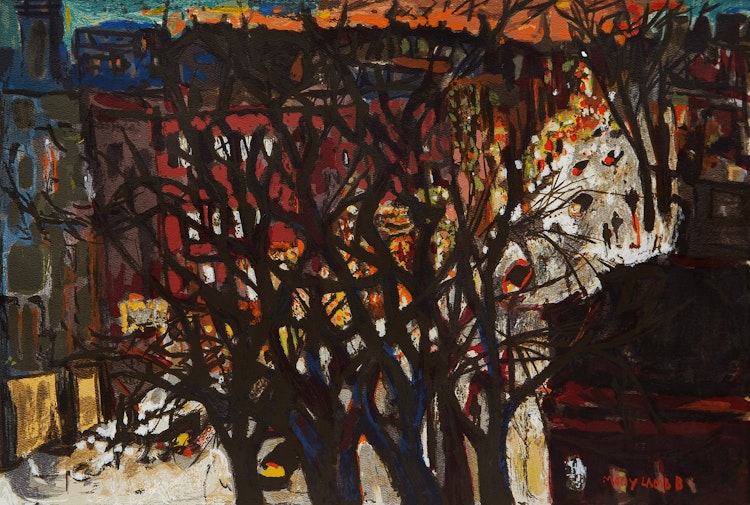Winter in Town by Molly Lamb Bobak

Molly Bobak
Winter in Town
colour serigraph
signed lower right; unframed
20.5 x 28 ins ( 52.1 x 71.1 cms ) ( sheet )
Sale closed. Please contact us for details.
Private Collection, Montreal
Share this item with your friends
Molly Lamb Bobak
(1920 - 2014) RCA
It could be said that Molly Lamb Bobak was destined to be an artist. She was born on Lulu Island, near Vancouver, British Columbia, on February 25, 1920. She grew up in a bohemian enclave. Her father, Harold Mortimer Lamb, was a photographer and art critic. In 1926, her father opened a commercial art gallery in Vancouver, exhibiting painters, sculptors, and photographers.
In 1938, Bobak attended art school at the Vancouver School of Art and studied under Jack Shadbolt, where she learned to improve her drawing and composition skills. While working at the Yellow Point Lodge during the summer of 1940, Lamb kept a diary filled with text and caricatures and drew everyone that she encountered. Bobak joined the Canadian Women’s Army Corps in 1942. While serving, she found endless material to paint and included these paintings in her personal journal, which was later published and titled “W110278: The Personal War Records of Private Lamb, M”, which included 147 folios and fifty single sheet sketches. After being stationed in Alberta and Quebec, the military recognized her artistic abilities and invited her to attend a drafting course in Toronto. After finishing the course, Lamb tried to become an official war artist. In 1942, Lamb was sent to Ottawa where she drew at the Trades Training offices where she designed posters and Christmas cards. Three of Bobak’s drawings were purchased by the Art Gallery of Ontario in the same year.
In 1944, “Meal Parade, Hamilton Trades School” (n.d) tied for second prize at the National Gallery’s Canadian Army Art Show, which helped her receive the appointment as a war artist––the only woman who earned this designation. As women were not allowed on the active war front, Bobak was transferred to London, England, six weeks after Victory Day to document the aftermath of the war.
After leaving the military, Bobak settled with her husband Bruno, in Vancouver. After the move, Bobak had little time to paint as she was teaching night courses at the Vancouver School of Art and tending to her children. After earning a French scholarship in 1950, Bobak, her husband, and their two children traveled to Paris where she experienced the works of modernist painters like Cézanne and Matisse. Cézanne’s work in particular influenced Bobak’s art, which can be seen in the geometric organization of “A Bakership, Saint-Léonard” (1951) and “The Saint Ives Train” (1951). Throughout the late 1950s, the Bobaks spent much of their time in Europe after receiving funding from the Canada Council for the Arts.
“In 1961, issue 71 of Canadian Art, a survey of 24 Canadian artists appeared, which included her photo, works, and comments written by Robert Fulford. Joan Lowndes in 1963 noted fewer flower pieces and more bustling cityscapes, outdoor activities and scenes with crowds of people in her work and linked her in this way to Pegi Nicol MacLeod. Making particular reference to her paintings of pubs she described this work in the following words ‘Only the figures in the foreground are silhouetted, in a heavier, more emphatic line and in new, high-keyed red orange. They recede into mere ovals, then into a haze of off-white and pink, which we readily translate into cigarette smoke, chatter, joviality . . . Molly Bobak powerfully projects an atmosphere’. This is perhaps the most essential quality of her work.”
After returning to Canada in 1961, Bobak was included in the second and third Canadian Biennales. Bobak exhibited frequently at the Beaverbrook Art Gallery, the University Art Centre in Fredericton, and throughout other public locations in the Maritimes. In 1973, Bobak was elected into the Royal Canadian Academy of Arts, and in 1995 she was chosen to receive the Order of Canada. In 1993, the MacKenzie Art Gallery in Regina, Saskatchewan presented a major exhibition of Bobak’s work that toured to Ottawa, St. John’s, and Fredericton.
“Though she favoured watercolours, Bobak also worked in oils, conte and charcoal, working in an impressionistic style more concerned with capturing the essence of the scene rather than the details of her subject matter. Molly Lamb Bobak stopped painting at the age of 84 when her eyesight began to deteriorate and she passed away in 2014. Bobak's work can be found in the collections of the National Gallery of Canada, the Canadian War Museum, the Art Gallery of Greater Victoria, the Glenbow Museum, the Beaverbrook Art Gallery, the Military Museums of Alberta, and the Art Gallery of Alberta.”
Literature Sources:
"A Dictionary of Canadian Artists, Volume I: A-F", compiled by Colin S. MacDonald, Canadian Paperbacks Publishing Ltd, Ottawa, 1977
Gewurtz, Michelle. Molly Lamb Bobak: Life and Work. Toronto: Art Institute of Canada, 2018 (https://aci-iac.ca/art-books/molly-lamb-bobak)
We extend our thanks to Danie Klein, York University graduate student in art history, for writing and contributing this artist biography (with passages quoted from “A Dictionary of Canadian Artists).

